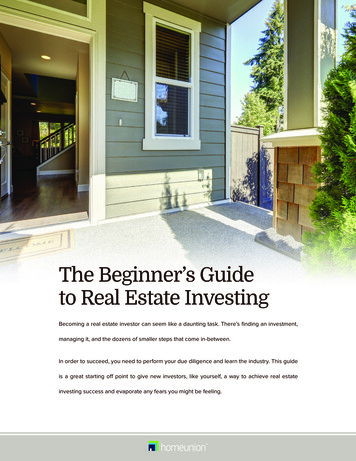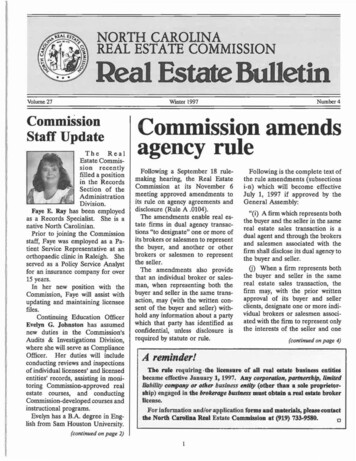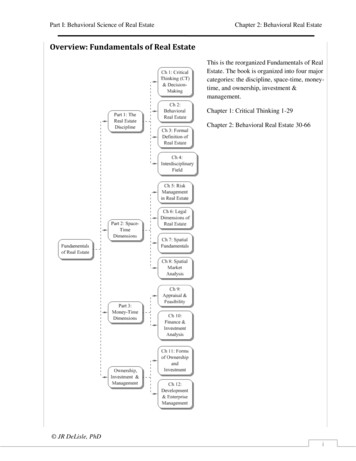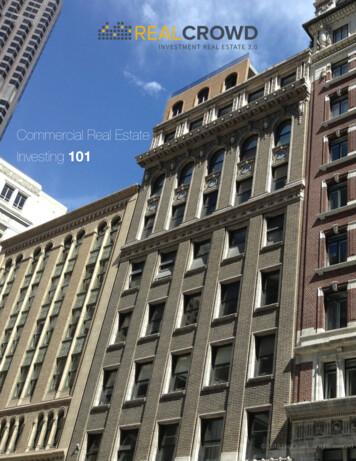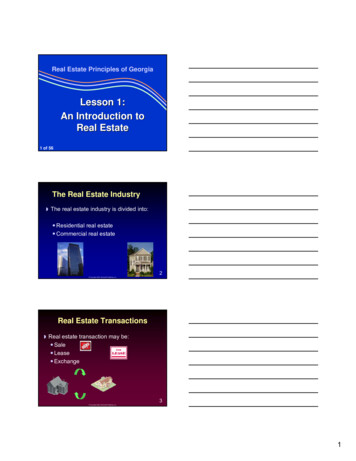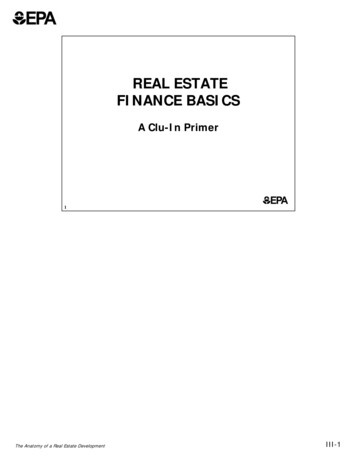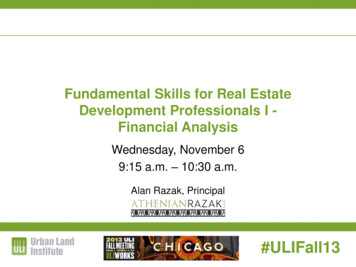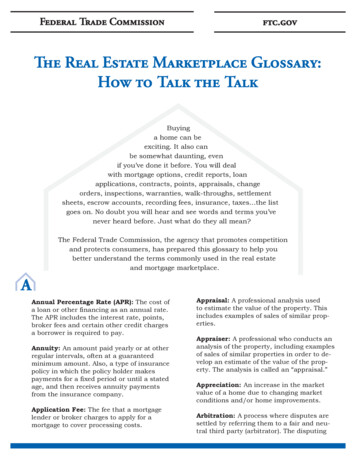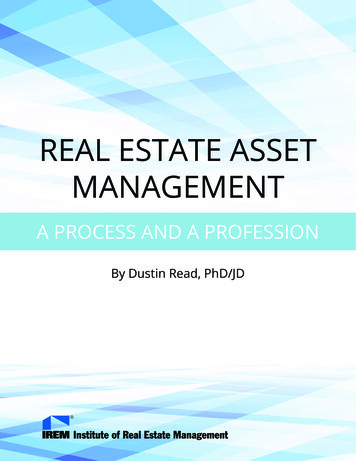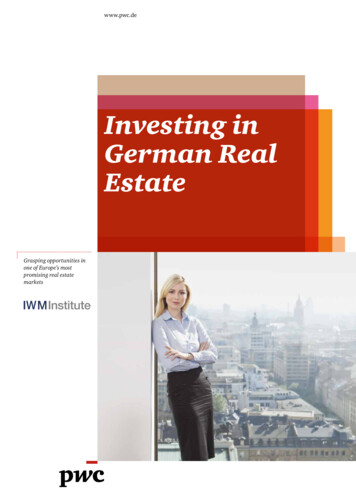
Transcription
www.pwc.deInvesting inGerman RealEstateGrasping opportunities inone of Europe’s mostpromising real estatemarketsIWMInstitute
Investing inGerman RealEstateGrasping opportunities inone of Europe’s mostpromising real estatemarketsIWMInstitute
Investing in German Real EstatePublished by PricewaterhouseCoopers GmbH WirtschaftsprüfungsgesellschaftBy Prof Dr Florian Hackelberg (IWM) and Dirk HennigFebruary 2018, 58 Pages, 23 Figures, 4 Tables, Soft coverAll rights reserved. This material may not be reproduced in any form, copied onto microfilm or savedand edited in any digital medium without the explicit permission of the editor.This publication is intended to be a resource for our clients, and the information therein was correct tothe best of the authors’ knowledge at the time of publication. Before making any decision or taking anyaction, you should consult the sources or contacts listed here. This content is for general informationpurposes only, and should not be used as a substitute for consultation with professional advisors. Theopinions reflected are those of the authors. The graphics may contain rounding differences. February 2018 PricewaterhouseCoopers GmbH Wirtschaftsprüfungsgesellschaft.All rights reserved.In this document, “PwC” refers to PricewaterhouseCoopers GmbH Wirtschaftsprüfungsgesellschaft,which is a member firm of PricewaterhouseCoopers International Limited (PwCIL). Each member firmof PwCIL is a separate and independent legal entity.
PrefacePrefaceIn recent years, the German real estate markets have established themselves as asafe haven for international capital flows both in terms of use types and locations.Although Germany is a popular investment destination among investors for beingstable, it is far from being static.In the last three years, market developments have gained additional momentum,made evident by rising transaction volumes and decreasing yields. This is mainlydue to the excellent economic and political conditions, a highly professionalisedindustry and low purchase prices compared to other countries in an attractiveinterest rate environment.Susanne Eickermann-RiepePwC German Real Estate LeaderLow interest rates are pushing further investment in real estate. However, a lackof product and high competition is continuing to put pressure on real estate yields.Many investors are looking for opportunities to invest in B or even C locations,value-added real estates, project developments, or in asset classes once reserved forspecialised investors like hotels, health care properties, etc.In our market study Emerging Trends in Real Estate, Europe 2018, we were able toidentify digitisation and urbanisation as the industries’ core topics. We analysedhow these megatrends drive the markets today and, based on this analysis, deducedhow the different real estate markets will develop. Driven by the digital revolution,former niche products such as logistics real estate have gained the status of coreinvestments. Furthermore, data centres have emerged as a completely new assetclass. Due to the strong demand for rare prime assets, it is more and more commonto undertake extensive revitalisation efforts of properties under the manage-to-corestrategy.Dirk Hennig P wC German Real EstateValuation LeaderBoth direct and indirect real estate investments in Germany are more popularthan ever before. German as well as foreign companies are pursuing cross-borderconsolidation efforts to leverage synergies. Although the investment markets havebeen in global competition for several years, local market and industry expertiseare essential in order to be able to make optimal investment decisions in the raceto achieve targets. In our daily dialogue with customers, we keep our finger on thepulse of the markets, continuously redefine our comprehensive consulting approachand expand our product portfolio by applying innovative tools.This study aims to contribute to a better understanding of the German real estatemarkets, their drivers as well as the regulatory framework. Please do not hesitate tocontact us to talk about your experiences.We look forward to constructive discussions and wish you an inspiring read.Berlin, February 2018Susanne Eickermann-Riepe6 Investing in German Real EstateDirk Hennig
PrefacePrefaceThe German real estate sector has been stable for several decades, with only verymoderate growth rates compared to other European countries. With the ending ofthe global financial crisis in 2010, this sideward movement changed and a dynamicmarket development gained remarkable momentum. Today Germany is one of themost promising real estate markets in Europe. Its diverse nature, however, meansthat most statements concerning “the” German real estate market as a whole aremisleading; it is therefore necessary to take a closer look at the market structure,which is both geographically divided and sectorally diverse.While many rural regions in the north and east are suffering from shrinkingpopulations and a decreasing demand for real estate, the metropolitan areasare booming. Due to Germany’s federal structure, there is not one predominantmajor city that represents the vast majority of the country’s property market, asseen, for example, in France with Paris or in the UK with London. What makes theGerman market interesting is that Berlin, Hamburg, Munich, Frankfurt am Main,Dusseldorf and Cologne – the so-called Big Six – are all compelling investmentdestinations. Together with its strong economic base and stable growth rates,Germany is increasingly attracting foreign real estate investors, a developmentwhich led to a record number of international market participants in 2016 and 2017,surpassing even pre-crisis figures. With uncertainty in the European peripheryand unclear Brexit negotiations on the way, this trend might go on with investorslooking for safe havens and investment opportunities for their capital.Prof Dr Florian HackelbergIWM InstituteHowever, like any other real estate market, the German real estate market has itsown dynamics and local regulatory framework that must be understood beforeinvestments can be successfully made. To this end, the following study includesan introduction to Germany’s tax conditions and regulatory and legal frameworksin addition to providing an overview of market sectors and their respectivedevelopments. The last section outlines general procedures and due diligence stepsto be performed when investing in the German real estate market.This study is intended to provide a solid overview of the German real estate marketand to be the first step towards making a successful investment. If you have questionsor would like further information, please do not hesitate to get in touch with us(info@iwm-institute.com).Berlin, February 2018Prof Dr Florian HackelbergInvesting in German Real Estate 7
Table of contentsTable of contentsTable of figures. 10Table of tables. 11A Basics of the German real estate market.121Structures of the real estate market.131.1 Location structure.131.2 Institutional real estate investment structure. 161.3 Investment turnover.18B Market conditions.201The residential property market.211.1 Supply.231.2 Demand.231.3 Rental price development.251.4 Purchase price development.271.5 Investment turnover.28Market for office properties.3022.1 Available office space offer.302.2 Office space turnover.312.3 Vacancy rate.322.4 Top rents.333Market for retail properties.353.1 Available supply of retail space.353.2 Rent development.353.3 Investment turnover.36C Regulatory framework.381Legal restrictions.39Legal protection of property in Germany.3922.1 Property ownership.392.2 Housing ownership.39Regulatory framework for property acquisition.4033.1 Purchase contract and land register.403.2 Procedure for transfer of ownership.40D Tax conditions.421Types of tax and real estate.43E Financial framework.44Traditional financing.4512Subsidies.462.1 Energy efficiency subsidies.462.2 Investment support.468 Investing in German Real Estate
Table of contentsF Guidelines for investment in Germany.471Asset deal versus share deal.481.1 Asset deal.481.2 Share deal.492Relevant due diligence areas.492.1 Asset deal – real estate due diligence and valuation.502.2 Share deal – real estate due Investing in German Real Estate 9
Table of figuresTable of figuresFig. 1Major real estate locations in Germany.13Fig. 2Regional shift and population concentration in metropolitan regions.15Fig. 3 Individual and portfolio investments in commercial real estateby institutional investors. 16Fig. 4Institutional real estate investment structure. 17Fig. 5Transaction volume according to the risk profile of the investment. 17Fig. 6Investment in commercial real estate by type of use.18Fig. 7Origins of capital according to region.19Fig. 8Distribution of population by tenure status, 2015.22Fig. 9Expected future development of households until 2035.24Fig. 10Development of size of households.24Fig. 11Residential rent index 1995–2016, 2017.25Fig. 12Residential price increase by city size.27Fig. 13 Flat prices per square meter in large German cities with priceincrease in per cent in 2016.28Fig. 14 Development of transaction volume for residential portfoliosin Germany.29Fig. 15Available office space, 2008–Q3 2017.31Fig. 16Office space turnover, 2007
Basics of the German real estate market The economic situations of the individual regions in Germany differ somewhat and the gap between growing and shrinking areas is increasing. In economically weak areas with decreasing populations, the real estate sector is confronted with vacancies as well as price and rent declines. At the same time, there are growth regions in which rents and
